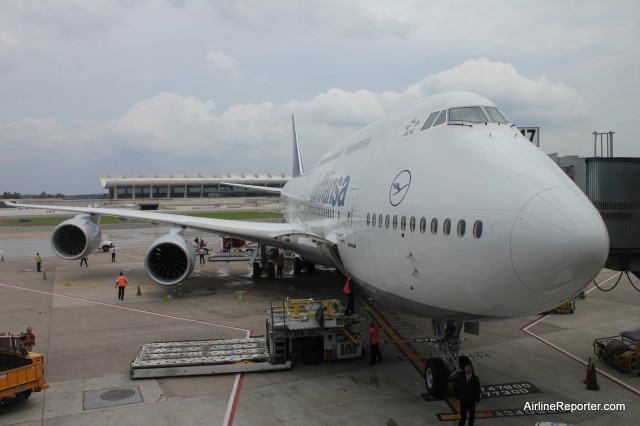
Lufthansa's first Boeing 747-8 Intercontinental is one beautiful aircraft. Here she is seen after her first flight in DC.
It has been a long road from the conception of the Boeing 747-8 Intercontinental to the first passenger flight on June 1, 2012. Being based in Seattle, I have had the privilege of watching Lufthansa Airlines first 747-8I go from a few parts to a revenue-making machine. I felt beyond lucky when I was invited by Lufthansa to take part on their inaugural flight from Frankfurt Airport (FRA) to Washington Dulles International Airport (IAD).
It was a whirlwind trip; leaving Seattle on a non-stop flight to Frankfurt, arriving at 8am local time and about 24 hours later, leaving on the 747-8I (I will write a future story on my 24 hours in Frankfurt). Fifty-eight hours and 12,000 miles after I left, I was back home in Seattle — well worth the adventure.
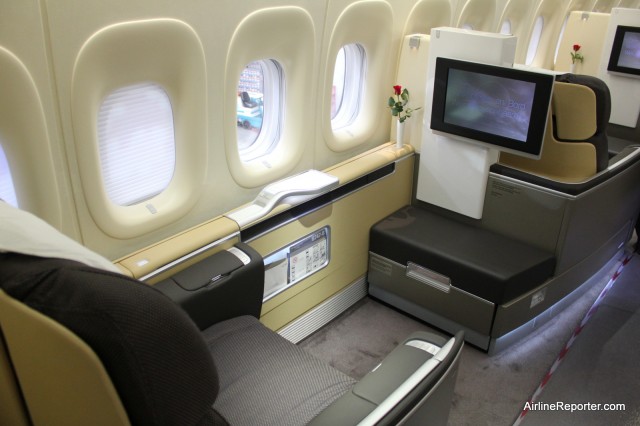
A look at Lufthansa's First Class on board the Boeing 747-8I.
There has been plenty of prep work by Lufthansa to train their crews on the new aircraft type. Currently, the airline has ten pilots qualified to fly the 747-8I, but soon they will have many more. Pilots trained on the 747-400 only need a three-day training course and a flight on the new plane to be qualified. Since Lufthansa just recently acquired the 747-8I, it hasn’t had many opportunities to allow pilots to fly it, but that will now change.
Unfortunately, I was not able to attend the delivery ceremony, so I was excited to get on board my first Intercontinental. During my 24 hour blitz in Frankfurt, there was a special unveiling event allowing me to preview the new 747 and to get access to First Class.
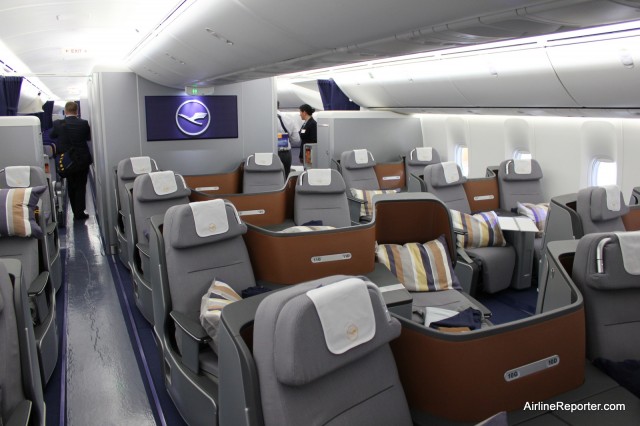
Lufthansa Airline's new Business Class product, which has debuted on the 747-8I.
For the average passenger, he/she might not notice that the 747-8I is something new. From the outside, one might notice the raked wingtips versus the winglets of the 747-400 or the larger upper deck, but it most likely will take the trained eye of an avgeek to see the difference. Inside, there are features, like LED lighting, improved overhead bins, and a feeling of space, that have become familiar on the 787 Dreamliner and 737 with new Boeing Sky Interior.
Not only is the 747-8I a new aircraft for Lufthansa, but it also debuts the airline’s new Business Class. I had seen photos previously, but photos do not do it justice. The new product is much more spacious, cleaner and just plain (or should it be “plane”) better in person.
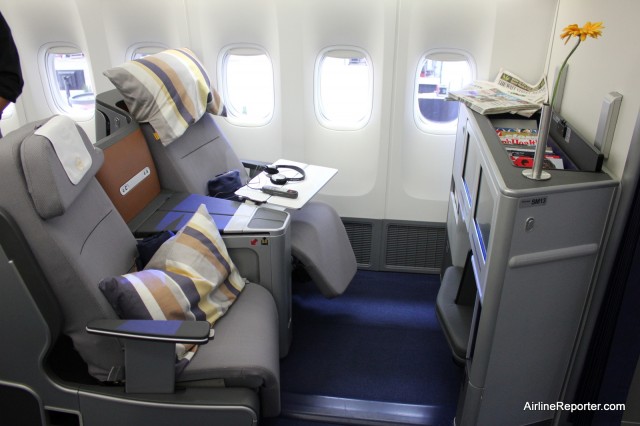
The new Business Class looks classy and has all the bells and whistles that high end fliers have come to expect.
The new business seats are unique to Lufthansa and will not be found on any other airline. They are in a V-shape 2-2-2 layout with each seat having the feet angled towards each other. I wasn’t quite sure how it would work out and worried that I might have ended up playing footsies with my seat-mate. Luckily, that was not a problem.
The pair of seats in the middle of the aircraft have an advantage over those by the windows — they have more room. With these biz seats, passengers might actually prefer the center seats, although I felt my seat had more than plenty of space.

Lufthansa has its Boeing 747-400 configured with 344 seats and its Airbus A380 with 526 seats — both in a 3-class layout. The new Intercontinental is configured with 362 seats with eight in First Class, located in the nose of the aircraft, 92 Business Class seats, with 32 on the upper deck and the remainder on the main deck, and 262 in Economy class, all found on the main deck.
Lufthansa will continue operating the 747 on more premium routes, since they have a higher percentage of premium seats versus the A380.
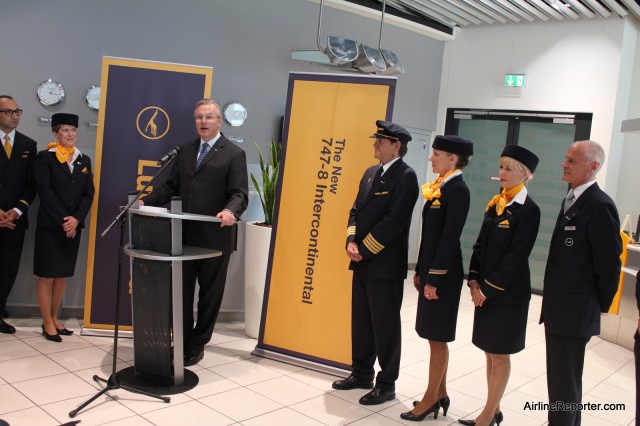
Lufthansa CEO Christoph Franz says a few words before we depart. FYI: "Boeing 747-8 Intercontinental" in German sounds amazing.
Before departure, there was a ceremony at the gate’s Business/First Class lounge with executives of both Lufthansa and Boeing present. After a glass of champagne and some applause, it was time to board the sparkling 747-8 Intercontinental.
Even though I was on the same plane a day earlier, the energy is entirely different when you are just checking out the interior, versus when you are able ready to take flight. “Epic” and “giddy” would probably be appropriate words to describe it.
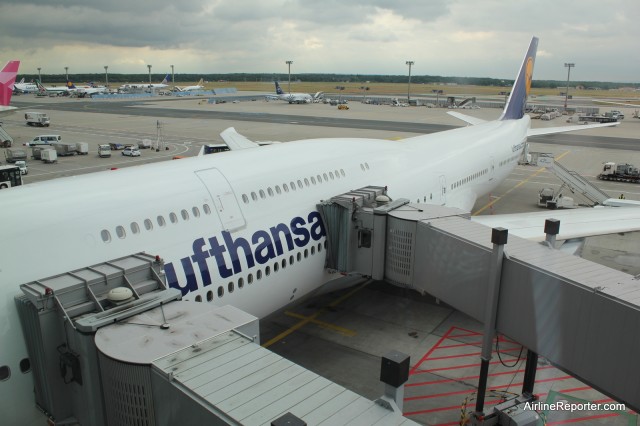
Time to load up. Lufthansa has gate lounges where folks in premium cabins can board directly from the lounge. Keep it classy people!
I had seat 10K — a window seat in Business Class, located on the main deck. I quickly got settled in and was ready to start on an historical journey.
This inaugural flight was unique since there were only 75 invited guests and media and the rest were paying passengers. Most airlines won’t have “normal” passengers on inaugural flights, so it was great seeing all the people (some who had no idea) enjoying the experience.
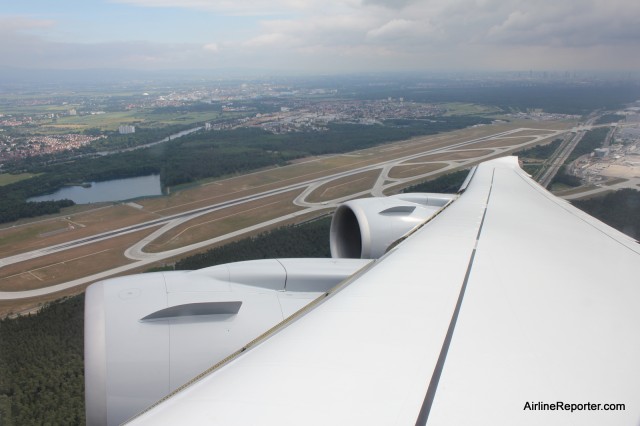
And we have lift off!
How was the flight? Amazing, unforgettable, awesome (insert your positive adjective here). The Intercontinental is not only a beautiful aircraft, but one that flies very well. During take-off, it was music to the ears hearing the four GEnx engines spool up. The large aircraft used a good chunk of the runway before lifting off and once airborne, the aircraft was quiet and allowed you to easily talk to the person next to you.
I was seated right in front of the right wing, which provided great views. I could easily witness the wings flex up, similar to the 787, but not quiet as dramatic. I was actually happy when we hit a pocket of turbulence, because I was able to watch the engines and wings do their dance.
It might take some training of the flight attendants to reassure worried passengers that the wings are supposed to do that.
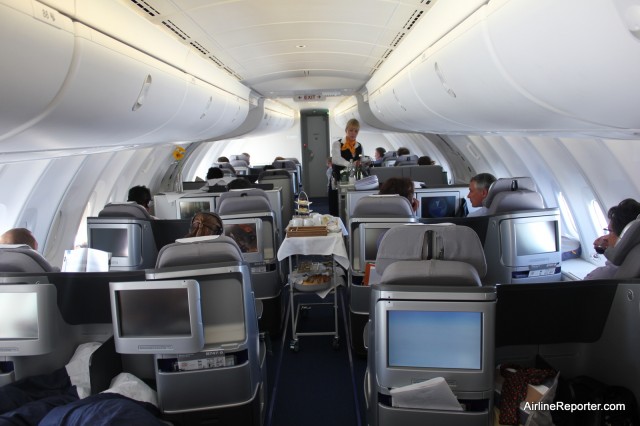
The upper deck of Lufthansa's Boeing 747-8 Intercontinental.
Moving a few times from the main deck to the upper deck, I noticed that up top was a bit louder due to wind noise. It is not enough that a passenger would choose the main deck, but enough that it could be observed.
I know many of you are wondering; how does the Airbus A380 compare to the Boeing 747-8 Intercontinental? Well, it is not an easy comparison to make. I haven’t flown on an A380 in a while and without back-to-back flights, it is hard to award an overall winner.
In a beauty contest, hands down, the 747-8 takes the crown. The A380 is a cool looking machine that functions well, but it doesn’t have the grace (nor history) that the 747 has. In the noise department, I think the A380 probably wins out.
The A380 and 747-8I are both great aircraft with their own benefits, but have different missions. Really, with how Lufthansa configures their aircraft, the Airbus A340-600 probably competes more directly with the new Intercontinental than the A380 does.
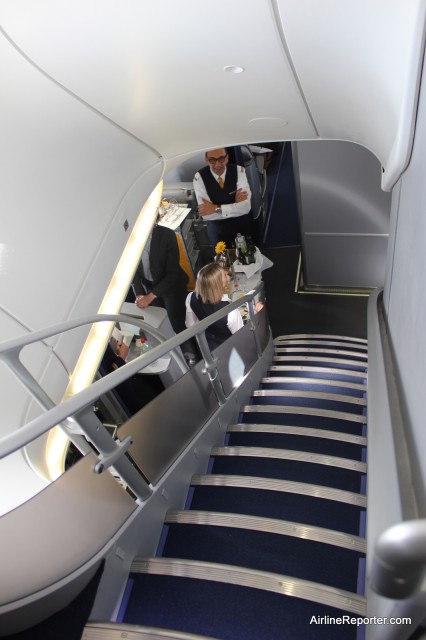
Down we go! it might not be the spiral stair case of the historical 747's, but it does the job.
During the flight, I had ample opportunity to put the new Business Class to the test. It is a huge improvement over the old product — which isn’t too shabby, but it is starting to show its age.
Each person is given plenty of room, a larger screen and a lie-flat seat. There are additional nooks to store things, an easier to use in-flight entertainment system and one of my favorite things that probably will go unnoticed: the ability to put down your arm rest to have more room sitting or sleeping.
The in-flight entertainment system will be familiar to frequent Lufthansa flyers, but it is much crisper and quicker. There are additional viewing choices, but I would still like to see more. I am able to forgive the lack of choice, since the IFE offers a camera view looking forward and down from the front of the aircraft.

The center arm rest holds your head phones, remote, tray table, but you have to make sure your arm doesn't hit those buttons.
For me, the biggest drawback with the new Lufthansa Business Class is the placement of the seat controls. They have been moved from the remote to a prominent location on the front of the arm rest. On more than one occasion my arm would accidentally hit one of the buttons and my seat would start to unexpectedly move. Asking others who also made the flight, they didn’t seem to have the same issue, so maybe it was just me (and my muscular arms getting in the way — okay probably not).
I was planning on staying awake the entire flight to absorb the entire experience, but after a few celebatory cocktails and my lack of sleep kicking in, I crashed for about one and a half hours. Since the sleep caught me off guard, I did not put the seat in the lie-flat position, but I rested comfortably without waking up in the half-way position. I have to say that the new pillow and blanket are a positive improvement and it is sometimes the little things that count the most.
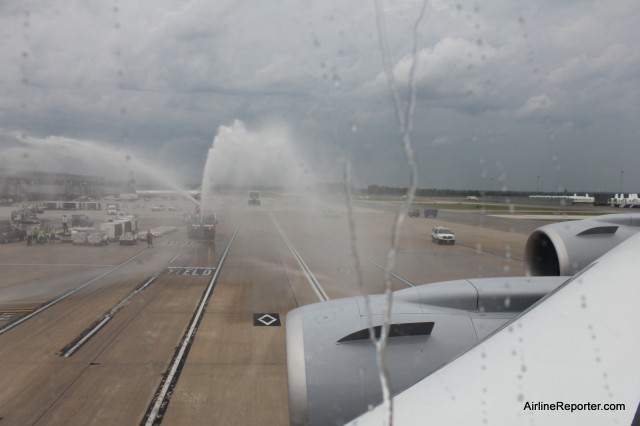
It is rare to get two water cannon salutes, but FRA gave us one leaving and this is IAD's one to us when we arrived.
When we started our descent, I wasn’t ready for the flight to end. The touch down was smooth and our welcome was warm. We had a water cannon salute at the gate and a group of media, guests and employees taking photos from the tarmac. We were escorted through customs and brought to an arrival party at the main terminal. Unfortunately, I wasn’t able to stay long, since I had to be off on my flight back to Seattle.
This 747-8I inaugural flight was much more than just a flight. It represents all the hard work (and patience) of all the people who worked so diligently to make it possible. I know that it sounds cliche, but I think this aircraft has been well worth the wait.
Lufthansa is planning on taking delivery of four more Intercontinentals before the end of the year and Boeing has stated on the flight there are other airlines (even ones in the US) that are showing interest in the 747-8.
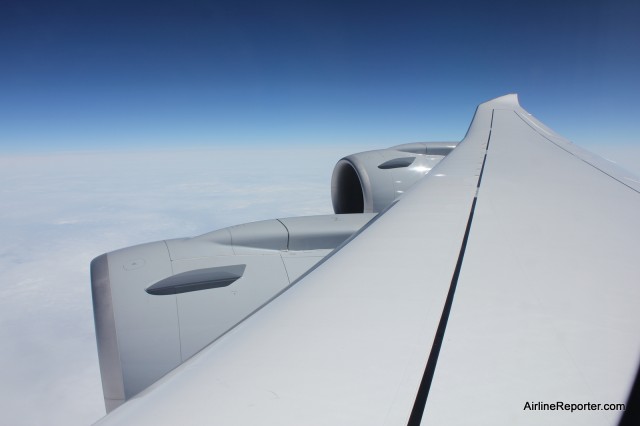
The photo doesn't do a great job showing the wing curve -- you will just have to go see it for yourself.
I am happy to celebrate the new Queen of the Skies initiation into revenue service. It starts with only one flight and one airline, but it won’t be long before millions are hopefully able to enjoy the benefits of the historical and new Boeing 747-8 Intercontinental.
SEE ALL 51 PHOTOS FROM THE LUFTHANSA BOEING 747-8 INTERCONTINENTAL INAUGURAL FLIGHT
Learn, Read, See More on the Flight:
* Photos on AirChive.com
* Video, photos and story on Jaunted.com
* Story on Wi-Fi on Lufthansa’s 747-8I via APEX blog
* Shots of us landing at IAD from @RacingWinds
At a time of “Occupying Wall Street,” type of protests seen around the world, it is interesting timing to take a look how airlines are creating a larger difference between low class (economy), upper class (first/business class) and middle class (economy plus).
Many American airlines have been suffering since 9/11, but have more recently started making profit again. Others have also been distracted with mergers (America West & US Airways, Delta & Northwest and still United & Continental), which has left many premium products (especially domestic ones) aging. Recently, airlines have started putting money into their premium products, while cutting options on economy, but why? I think there are a few reasons:
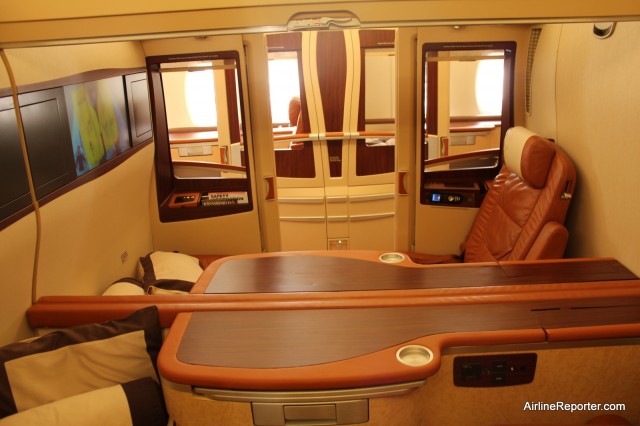
Singapore Airlines offers these suites on their Airbus A380's. They can cost over $20,000.00 round trip.
* Premium products, especially internationally, are very profitable
Scott Mayerowitz writing for the AP points out that, “first-class and business-class passengers make up only 8 percent of international travelers but account for 27 percent of revenue.” Why wouldn’t an airline go for where the money is at? At the end of the day, airlines are a business and they are meant to make profit. Now that they have money to make investments into products, does it not make sense to give passengers what they want? The wealthy want a better product and most of the non-wealthy want cheaper tickets.
* Legacy carriers need to keep their frequent fliers
Newer airlines, like Virgin America, have been shaking things up with-in the US. They provide superior first class and economy product and might make some of the frequent fliers on legacy carriers think twice. Take away points and rewards and what would you rather fly? On an old MD-80 aircraft (still flown by American and Delta) or a newer cabin on Virgin America’s new Airbus A320s?
* It is cheaper to keep a current customer versus the money to get a new one
It is basic Business 101. Companies will spend much more money trying to attract new customers than just trying to keep the ones they already have. It makes long-term financial sense to improve first class.
* Rich people want nice things, less rich want to get there as cheap as possible
It comes down to market demand. Those that do not have the money, normally want to get from point A to point B as cheap as possible. When comparing prices, they might see that it will cost $20 more for one airline, but would rather save that $20 (or $80 if a family of four) for their trip. However, this doesn’t stop the person from complaining about the lack of service and amenities.
Those that can afford the extra costs or have earned enough rewards to be upgraded, care more about the amenities offered. They are more willing to shell out some extra money for a higher level of service.
As Mayerowitz points out, “Most of the 3.4 million Americans expected to fly this holiday week won’t get anything close to that treatment. They’ve paid a little under $400 for their round-trip tickets. And it’s a cutthroat business. To save $5, passengers are likely to choose another airline.”
* There are some things given to economy, but most cost money
Just because economy passengers are not seeing the royal treatment, doesn’t mean they are not getting anything. Many airlines have been installing Wi-Fi onto their planes and are offering some pretty decent food options — but you have to pay for both. This allows airlines to offer rock bottom prices and additional add-ons that passengers can pay more to increase their level of service. This seems to be working for most airlines, since they are making record profits on the additional options in economy.
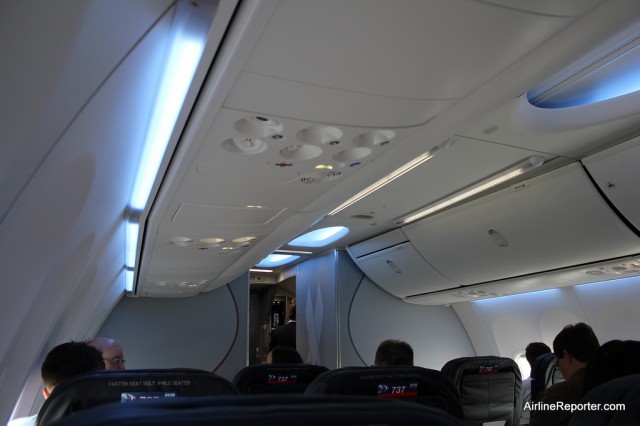
American Airlines is replacing some of their MD-80s with Boeing 737s with the new Sky Interior.
* The middle class now have an option
Flying used to be just for the rich. Then just for the rich and middle class. Now, almost anyone can snag a cheap ticket and flying is open to the masses. You have the rich up front, the non-rich in the back and now some airlines are offering premium economy options for the middle class. Delta , JetBlue, Frontier, United and Virgin America all offer premium economy seats, but is the extra cost worth it? I guess it depends on who you are and how long your flight might be.
Edward Russell, with NYCAviation.com, recently took a look at the different options and if they are worth it.
* Conclusion
I have been flown around the world in many airline’s premium products and have loved them. However, they would have cost me anywhere from $5,000 to $10,000 if I would have paid out of pocket — that is not even first class. When I am flying on my own dime, there is no way I could ever come close to afford that and mostly I am looking for the cheapest fare.
If one can consistently afford a premium product, I can understand getting spoiled and demanding a high-level of service. But for most of us, we are happy with getting to our destination as cheaply as possible. “They want their luggage. They want to arrive on time. They want the airplane to be clean,” Andrew Nocella, US Airways senior vice president of marketing explained to the AP. “Most importantly, they want a low fare.”
Airlines know that many people in economy just care about the low fare and that people who can afford a better experience care about amenities. If airlines are just giving passengers what they want, why do so many people always seem upset at them? Oh that’s right. Many people want to pay economy level prices, but get that first class treatment. I doubt we will be seeing that anytime soon.
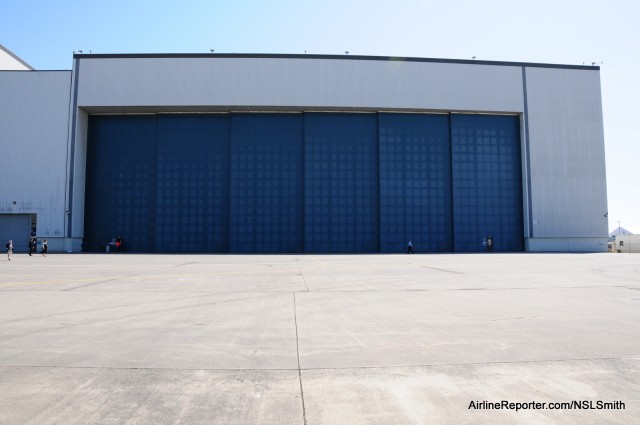
No curtains needed. This is a Boeing paint hangar located at Paine Field and where the first ANA 787 Dreamliner was painted.
Since the outside and the inside of the Boeing 787 Dreamliner is so amazing, I wanted to divide the photo posts into two. Earlier, I posted the interior tour of ANA’s first Boeing 787 and now it is time to take a look at the outside. Media was invited by Boeing and ANA to experience the roll out of this historic aircraft. It might not have been the first 787 to fly (this is airplane #8, called ZA101), but it will be the first Dreamliner to carry passengers.
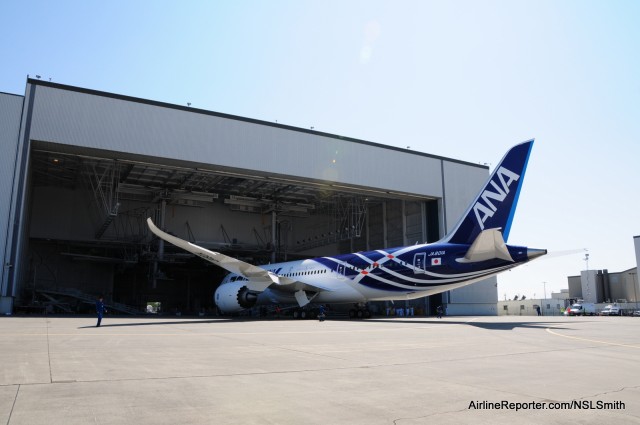
The 787 (JA801A) was slowly backed out of the paint hangar, bringing the new livery out into the sun for the first time.
ANA announced a special 787 livery that would go on their first two Dreamliners during the Paris Airshow. They showed off nice looking computer renderings, but of course it is hard to get a full feel of a new livery without seeing it in person (or seeing photos). Media folks were lined up waiting to watch the paint hangar doors open. With the sound of bells, the door slowly opened up, showing off the 787’s new paint scheme. I know on previous comments some of you have been skeptical of this special livery. It is a bit different, but I can tell you that it looks more amazing in person and I really like it.
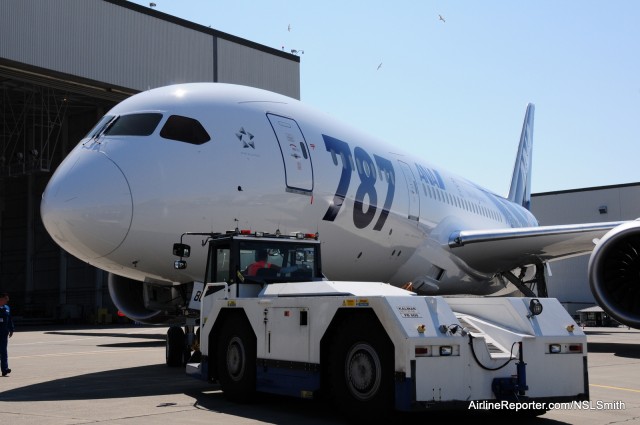
The 787 got towed right over the media. Right on. Notice the birds flying overhead.
As the 787 Dreamliner was being towed into place I was doing video and social media (I had a great friend, Nick Smith, helping me out with photos) and I wasn’t realizing how close the plane was getting to us. I was sitting on the ground and the right engine passed with-in a few feet as the wing went over head. Even the non-aviation geek media couldn’t help but say how awesome that was. The lighting for photos wasn’t the best, but this is the standard way the tug pulls aircraft out of the paint hangar and Boeing didn’t want to risk changing how things are done with the first 787 to be delivered.
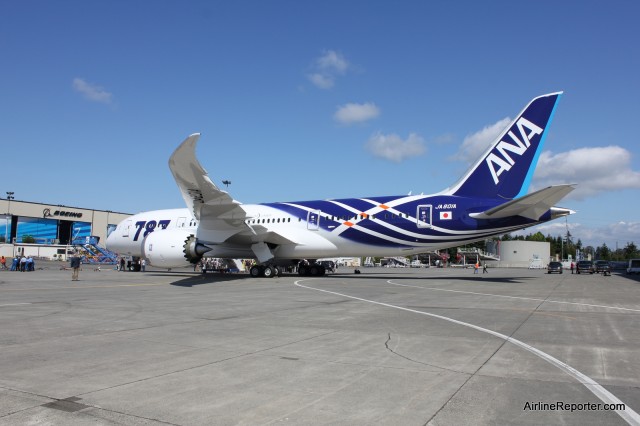
It is cool to think all the people that this Dreamliner will fly during its lifespan.
ANA’s first two 787 Dreamliners will have this livery and the other 53 they have on order will sport their standard livery. I was told these liveries will last the life of the paint, which is expected to be about five to six years before it will need to be re-painted. Unfortunately there was no update from Boeing or ANA on when this aircraft will officially be handed over to the airline. At this point, it is expected it should be delivered sometime in September and about a month after that ANA will put the aircraft into service.
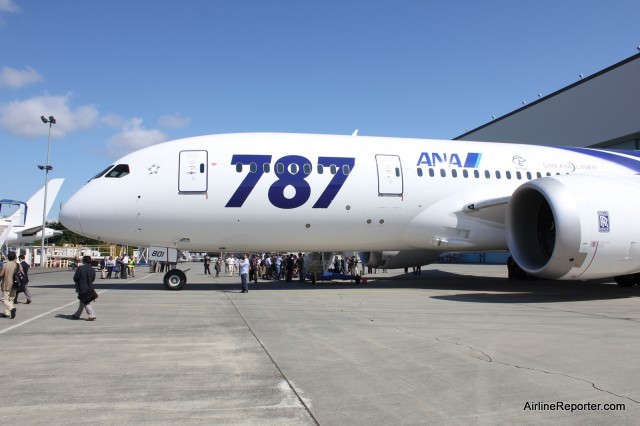
Even the non aviation geeks will tell this is the 787.
* Check out the interior photo tour of ZA101
* See all 33 photos of the exterior of ANA’s first Boeing 787 Dreamliner JA801A
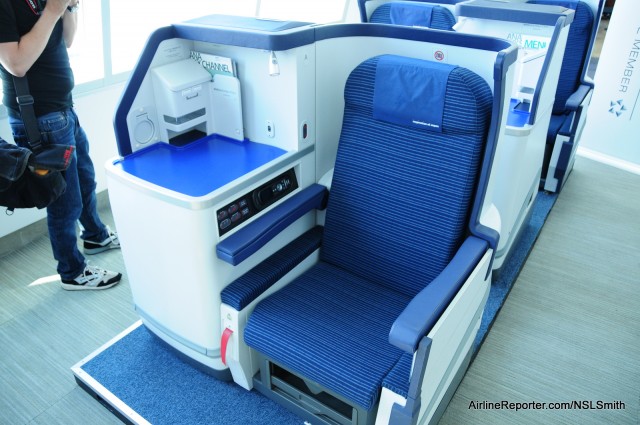
This is ANA's new international business class staggered seat on display at Boeing's Delivery Center.
Step by step Boeing is getting closer to delivering their first 787 Dreamliner to All Nippon Airways (ANA). Today was a huge milestone with revealing the special livery and allow media, ANA employees and invited guests the opportunity to take a look at the inside. This first aircraft that will be delivered (ZA101 – JA801A) will fly domestically with-in Japan, so it has ANA’s new domestic interior. ANA is proud of their new international staggered business class, so they had a few seats on display at Boeing’s Delivery Center that we were able to preview before heading out to the hangar.
I decided to give the seat a shot. At 6’1″ 250lbs, I was hoping for the best. I have flown in ANA international business previously and I really enjoyed the old product. Honestly, I felt the new seats seemed a bit bland looking, but I was told they were designed to look futuristic. The older product has wood and really gives a warm feel, but I suspect the new product will look much better in the aircraft and it does provide a lot more privacy and space to store your things. It is hard to get the full feeling of the seat with only three in a row on display versus seeing it in staggered configuration inside an airplane. Because of that, I will reserve final judgement for testing it out on a future international ANA 787 flight (fingers crossed on that one) or possibly on the newer Boeing 777-300ERs that are also flying the new staggered business class.
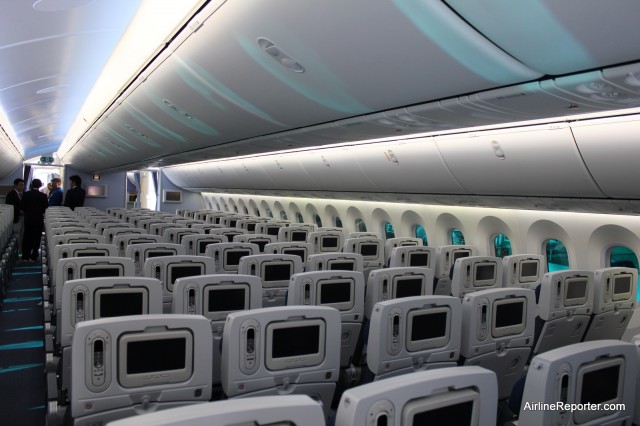
The tinted windows on the Boeing 787 Dreamliner makes odd "mood" lighting in the cabin.
I have felt privileged to previously been able to take an interior tour of Boeing’s third 787 Dreamliner, ZA003, but that one did not have a full interior. This aircraft looked like it was ready to take on customers with a full interior and it had that new plane smell (which smells very similar to a new car smell). When first walking on the 787 you get a feeling of space — it is not just Boeing PR talk, it is true. There are literal reasons with the overhead bins providing more space and the fact that the 787’s cabin is about 2.5 feet wider than the 767. The 787 also has LED lighting in the ceiling that also gives a greater sense of height and space.
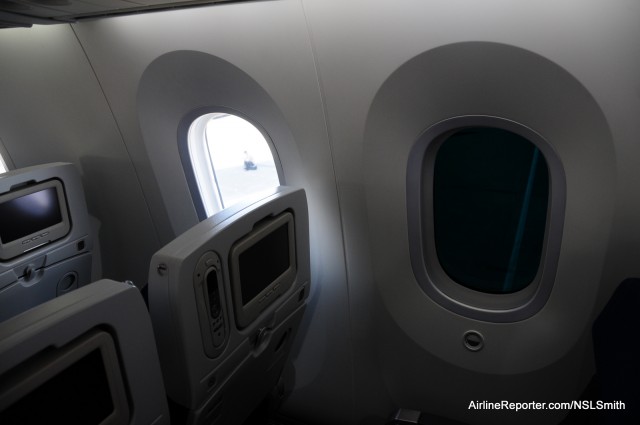
One window is clear, the other is darkened.
One of the many benefits of the 787 Dreamliner are the windows. Gone are the sunshades that either provide full light or complete darkness. The 787’s new smart-windows allow passengers to choose five different settings of tint. Even at the darkest setting, you are still able to see outside. The flight crew has control over all the windows at their computer station, giving them the ability to darken or lighten all the windows at the same time.
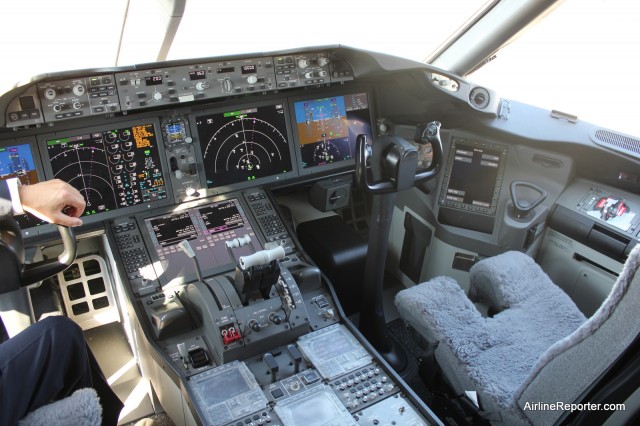
The best seats in the 787 Dreamliner are not in business class, but in the cockpit.
One cannot get a full interior tour, without a visit to the flight deck, which holds the best seats in the house. You could tell this 787 was new since there was protective plastic that was still on controls and displays around the cockpit. The pilots have an array of technology to make flying the aircraft easier and safer. Not only are there large screens that can easily show everything that is going on with the aircraft, but there are also Heads Up Displays (HUD) that allow the pilots to look out the front windscreen, while still seeing vital aircraft information like speed and altitude.
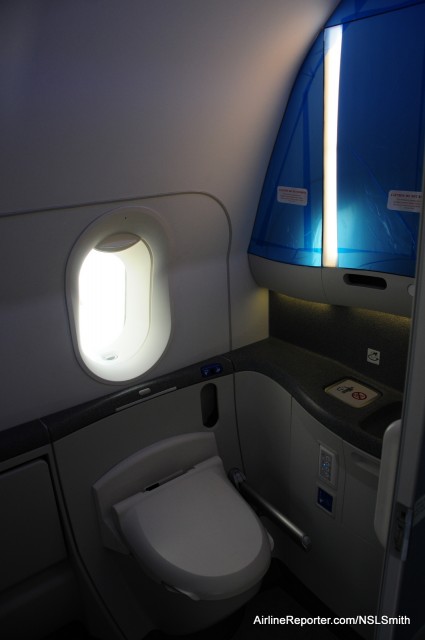
The center lavatory had a window. Notice the protective blue film still on the mirrors.
One of the most interesting features on the aircraft were the lavatories. First off, ANA has decided to offer female only lavatories, meaning that most restrooms will have an image of a male and female, but others will display a single female image. On this aircraft, the central lavatory had a window and the only shade on the aircraft. There is a dimming switch, but for those who want total privacy, you are able to pull down the shade. For those who are used to a certain level of service in the restroom, do not worry, each toilet has a bidet with special male and female settings.
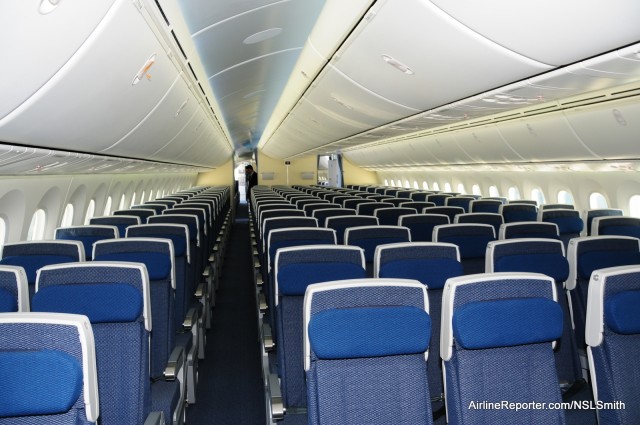
Looking to the back of the Dreamliner in Economy.
Since this was a 787 created for shorthaul flights, it has a small business class section and then economy in the rear of the aircraft. ANA was originally planning an economy-plus type section, but have decided not to implement that in this 787 for now.
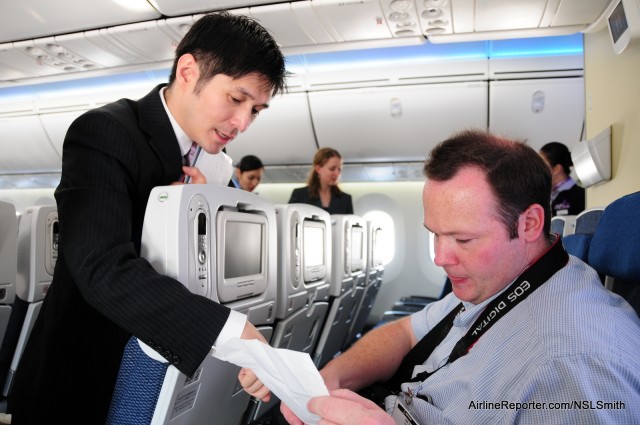
Here I am talking with Ryosei Nomura, who is Senior Manager of Public Relations based in Japan, about my thoughts on the new interior.
One of the interior updates are the fixed back shell economy seats. Those are the type that you can still push your button and the bottom part will move forward, but your actual seatback will not recline. This is to help save space for those behind you. Talking to some ANA folks, they stated they have received some negative feedback, but I really like the concept of the seats. I am one that will rarely reclines my seat out of consideration of those behind me and I hate it when I am working on my laptop and the person in front of me puts back their seat. With the seat in the “reclined” position, my knees were hitting the seat on front of me, but I was assured the longer haul economy will have a larger seat-pitch. But with my seat “un-reclined” I had no problems. Since it is not as obviously if your seat is reclined, each seat has an indicator on the head rest which will quickly show the flight crew if the seat is in proper position for take off or landing.
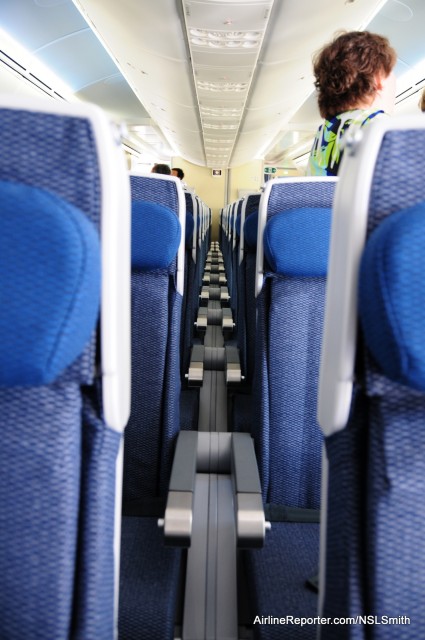
ANA has decided to provide a double armrest in the middle of their 787 Dreamliners.
The first aircraft in domestic configuration is laid out with 12 business class seats in a 2-2-2 layout and 252 economy in a 2-4-2 layout. The short-haul international configuration will contain 42 business class seats and only 180 economy. The long-haul international ANA 787 will fly 46 of the new business class staggered seat and 112 economy, providing more seat-pitch than the domestic aircraft. One aspect of ANA’s economy that wasn’t at first obvious was the center armrests. No one likes to be sitting in the middle of a 2-4-2 layout, but ANA gives passengers a double arm rest in the middle, making the it less painful to have that middle seat.
For the average passenger, it might not be totally obvious they are in a new 787 Dreamliner. However, they should notice that there is something different, something better about the aircraft. For those of us who know airplanes, it is very obvious this is a next-generation airliner. Yes, the 787 has been delayed three years, but once people start flying on them, I doubt many will care. I cannot wait for this to become the new standard in world travel. A big thanks to Boeing and ANA for holding this event and inviting AirlineReporter.com along for the ride.
* See an exterior photo tour of ANA’s first Boeing 787 Dreamliner
* Check out all 39 787 interior tour photos on my Flickr
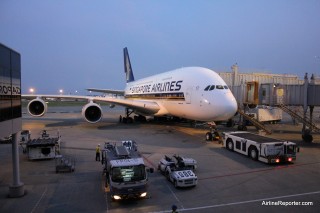
A Singapore Airlines Airbus A380 sits at Tokyo's Narita Airport.
When talking airlines, I have heard over and over again that Singapore Airlines had the best international business class product and I recently had the opportunity to try it out. It was on flight SQ11 and SQ12 which is an Airbus A380 that flies to and from Los Angeles (LAX) to Singapore (SIN) with a stop at Narita (NRT) in Tokyo (disclaimer: I was able to fly at no cost by the airline to and from Singapore).
I am pretty big guy, around 6’1″ and 250lbs or so, which means I can truly appreciate a larger seat with a little extra room. Most business class seats do a great job of making me feel comfortable, but Singapore Airlines business class seats border on insanely big. They have a seat pitch of 55″, which is nothing to write home about, but they also have a seat width of 34″ — which is almost three feet. To compare, the international business class seat width on Lufthansa’s Airbus A380 is 20″ and All Nippon Airways Boeing 777-300ER has a respectable width of 21″.
Singapore’s business class seats are arranged in a 1:2:1 layout, meaning every seat has access to an aisle. That eliminates having to trip over a seatmate in the middle of the night to use the restroom. Unfortunately I was not able to catch a window seat to or from Singapore, but with all the available in flight entertainment, who really needs a window anyhow (okay, I was disappointed, but it worked out).
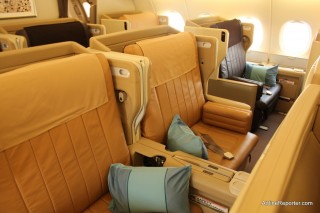
Singapore Airlines sets up their Business Class seats in a 1:2:1 layout -- meaning everyone has aisle access.
When taking a 20 hour flight twice in one week, there needs to be a decent collection of entertainment. Singapore Airlines came through, giving each passenger easy access to a better-than-average selection of movies, tv shows and music all on demand. You are able to recline back and still easily view the 15.4″ screens. I did end up having a few issues during my flights, where the entertainment system would tweek-out and restart on its own or cause my movie to stop for a bit. This happens to be a common occurrence since I have a knack of causing entertainment systems to crash. For some additional fun, there were quite a few “real” game options that you can play with other passengers, like Tetris and Battleship, but never got around to trying them out.
When it becomes time to sleep, the seats fold flat, but it requires you to stand up and fold the seat-back forward. The manual process was decided on to save the weight of additional mechanics, but it can be a bit annoying when you are about to fall asleep and you have to get back up to make the bed (yeah I know, life is rough). It is all worth the effort — I was able to sleep comfortably for about 7 hours on the flight home.
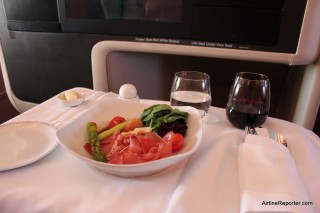
There were so many meals served on my flight to Singapore and back, with multiple courses, I am not even sure what this was. But I know it was good.
If you decide to sleep, you risk missing a meal or two — which would be a shame. Because of timing, I enjoyed three different dinners on the way over and two lunches and a dinner on the way back. My first meal started with parma ham and ginger-infused pear, char-grilled vegetables and balsamic dressing. Then the the main entree was seared beef fillet with port wine sauce, mushrooms in spice cream and dessert was New York cheese cake ice cream with cherry compote. Yes, a lot of fancy names, but it actually tasted quite divine.
Just when I thought the formal meal was done, here came a cart with cheese on a cutting board. You tell them what you want and they will cut it up, served with fruit and even a glass of port. Each meal has multiple courses and by the time the cheese cart rolls around you are pretty full. If for some reason you are hungry during the down times, there is still a “light bites” menu available, where you can get anything from noodles, to sandwiches to even a Krispy Kreme doughnut (only from LAX to NRT).
If you are feeling a bit more adventurous there is also an Asian option including seasoned kelp, grilled fresh water eel braised in egg and pike eel roll with kelp. I normally love trying different food, but was not in the right mood. It is always nice to have a drink while dining and if you become thirsty, no worries, you have eight pages of drink options to choose from including the classic Singapore Sling.
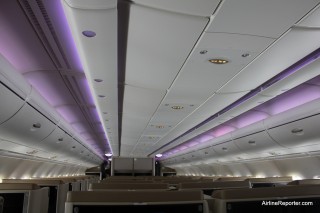
Singapore Airlines has different lighting modes for different parts of the flight on the A380. This purple was my favorite.
Singapore Airlines is very proud of their Singapore Girl brand of service and on board my A380 flight there were 23 flight crew. Something I didn’t notice on the way over, but learned while in the Singapore Airlines Training Center, is that the flight attendants have different ranks. Although their uniforms have similar designs, there is a variation of color based on seniority. The majority of men and women serving you will sport the color blue which is entry level. Green are the lead flight attendants in charge of a section and reds are chiefs in charge of each deck. On the A380 there will be one person in charge who sports purple. It became a game to try and find one of each color (hey, it is a long flight).
This is a new flight for the airline and was started on July 1. Singapore Airlines also operates a non-stop from Los Angeles to Singapore using an Airbus A340-500. Why would anyone take the longer trip with a stop in Narita? First, the non-stop flight (SQ37 and SQ38) is the second longest flight in the world and takes about 18 hours. That is a long time to be locked in a aluminum cylinder and some people might be willing to make the trip longer to have the ability to split up the trip with a short stop in Narita. Also, the non-stop flight only has business class seats, so if you are looking to fly first class or economy, the A380 flight is a must. If you are flying business class, the A380 product is similar, but the seats are wider compared to the A340. Probably the most important reason for airline geeks is the ability to fly on an Airbus A380 vs a more common A340.
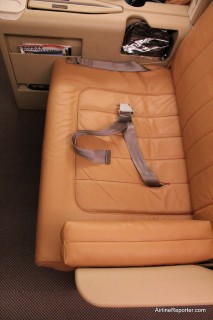
These seats are so wide that the seat belt comes up in the middle of the seat and they give you a pillow to fill space.
The first leg of the flight from LAX to NRT was about ten hours before a 1.5 hour lay over in Narita. Flying business class gave me access to the business class lounge, but it was a bit annoying having to get off the aircraft, go through security at Narita, before starting the boarding process.
Los Angeles becomes the eighth destination in Singapore Airline’s network to operate the Airbus A380. They were the first airline to operate the world’s larges airliner in October 2007 and they have clocked around 128,000 flying hours on more than 13,000 flights. The airline currently has 12 A380s in service and seven more on firm order. It is definitely worth the extra time to try out the A380 product and if you are flying economy, you still have a shot to fly on the upper deck.
Now, the bar has been set high. Have you flown in business class seats that you have found to be what you consider “the best”? If so, please tell me about your experience in the comment. Also be sure to check out my other photos of the flight including first class, the lay-flat business class seats, and my seat neighbor who was wearing cowboy boots.
































